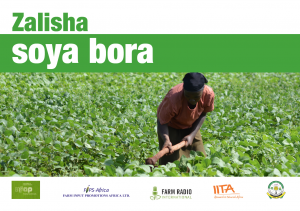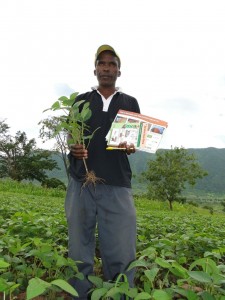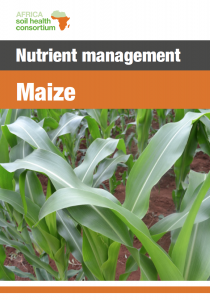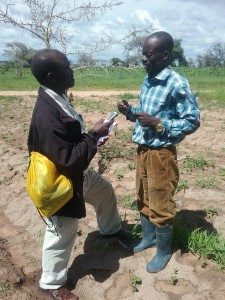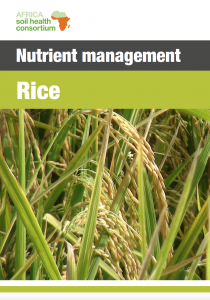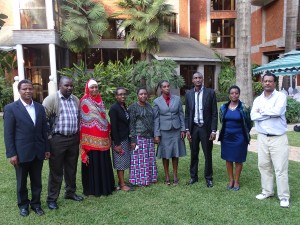ASHC Newsletter March 2017
26 March 2017: We have changed the way that we share information with you about the African Soil Health Consortium (ASHC). This quarterly e-newsletter will help you to understand how the new strategy is being implemented with news from the project: Gender and the Legume Alliance; OFRA; Scaling-up Improved Legume Technologies and UPTAKE.
We are also launching a Twitter alert, so that, in future, you will be able to receive information about news and new publications as soon as they are announced.
ASHC is now focusing on fewer countries, so far we have active project work in Ghana and Tanzania with Nigeria & Uganda at an advanced planning stage. We have been working with partners in these countries to set up campaigns delivering messages that support the integrated soil fertility management approach. In Ghana and Tanzania this has meant a strong focus on legumes (soybean and common bean) and close working with N2Africa and IITA .
Developing campaigns and materials
Our campaigns use a variety of complementary media that deliver messages into farming communities. By using multiple media (print, film shows, radio and SMS/voice telephony) alongside approaches (extension, demo plots and farmer training events) we hope that we will be able to learn which combinations are most effective at delivering attitude and behaviour changes. We are also especially interested in how different gender groups, especially women farmers and younger farmers, respond to the information.
- Tanzanian maize farmers to receive 1 million SMS messages (21 March 2017 news) The ASHC UPTAKE project looks at how its SMS campaign is going to scale
- A soybean campaign plan for Ghana (12 January 2017 blog) The ASHC team explains its quest to find out how effective different media, and combinations of media, can be at encouraging farmers to trial and/or adopt improved legume technologies
- Soybean and the gender agenda… (7 February 2017 blog) The ASHC team shares reflections on how the Ghana soybean campaign is nuanced by gender
- The right wave length: 70,000 radio interactions in Tanzania (28 February 2017 blog) Farm Radio International reflects on the level of interactivity in the radio programs in the legume campaigns in Tanzania
- Maximising partnerships to scale-up legume technologies in Tanzania (23 February 2017 blog) James Watiti and the CABI team explain how partnership working brings added benefits to a campaign approach
- SILT demo plots help close the yield gap (26 February 2017 blog) AFAP share progress from the demo plots and how they are starting to impact on farmer’s practice
Developing input and output markets (value chains)
Another significant change is that we are working more effectively with private sector partners within the supply chain to build access to the inputs required in the different technologies. Whilst information is essential, alone it is not sufficient to deliver sustainable change in farming systems. We are also developing much more systematic approaches to monitoring and evaluation.
- Tanzania: Fertilizer gives hope to soybean farmers (13 March 2017 blog) Daniel Semberya’s blog originally commissioned by Farm Radio International and published in BarzaWire looks at how fertilizer use can fortify plants
- 5 new crop nutrient guides to download (24 March news) The guides are designed for an extension audience and focus on the principles of fertilizer (nutrients and micro-nutrients) and organic matter use and the application of good agricultural practices such as intercropping
- Seed production starts to address chronic shortage (20 December 2016 news) How the SILT projects new partners work to address the legume seed shortage in Tanzania
- Access to market key to adopting improved legume technologies (30 January 2017 blog) Monica Kansiime of CABI, explores the roles of markets in keeping farmers wedded to traditional, low input, production methods
- ASA in Tanzania: Seeds of Success (20 March 2017 blog) Charles Levi of the Agricultural Seed Agency in Tanzania spells out the progress to make improved seed more readily available to farmers…
Sharing lessons from research on communication and value chains
Finally, we are committed to shortening the lead time to share the findings from ASHC. Over time there will also link to publications and reports sections of the website, as well as news and blogs.
- OFRA new book on Fertilizer Use Optimization in Sub-Saharan Africa (17 March 2017 news) Free to download 17-chapter book setting out the principles and approach of fertilizer use optimization, special optimisations and integrated soil fertility management in 13 participating countries in sub-Saharan Africa
- Gender and approaches: some indicative information (22 March 2017 news) Dannie Romney, ASHC project executive shares her thoughts on gender research undertaken with the support of Legume Alliance partners in Tanzania and currently informing the SMS campaigns in the UPTAKE project
- What agro-dealers think – a survey from Northern Ghana (12 February 2017 blog) Green Ef shares surveys and comments made by the agro-dealers giving a useful insight into their perceptions of opportunities and challenges
- OFRA shares its lessons (16 February 2017 blog) CABI has been working with AGRA to ensure lessons from OFRA are captured and shared
- Update from the SILT MSc students in Tanzania (20 February 2017 blog) IITA reports on the progress made by the MSC students in deliver their research
If you have any feedback or comments on anything you have read here, please do not hesitate to contact me.
James Watiti, ASHC project manager
j.watiti@cabi.org


